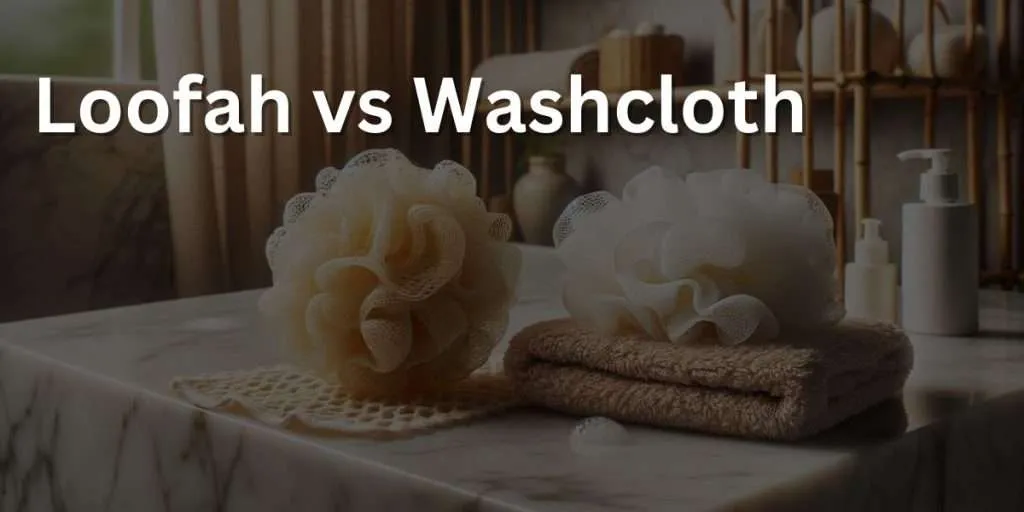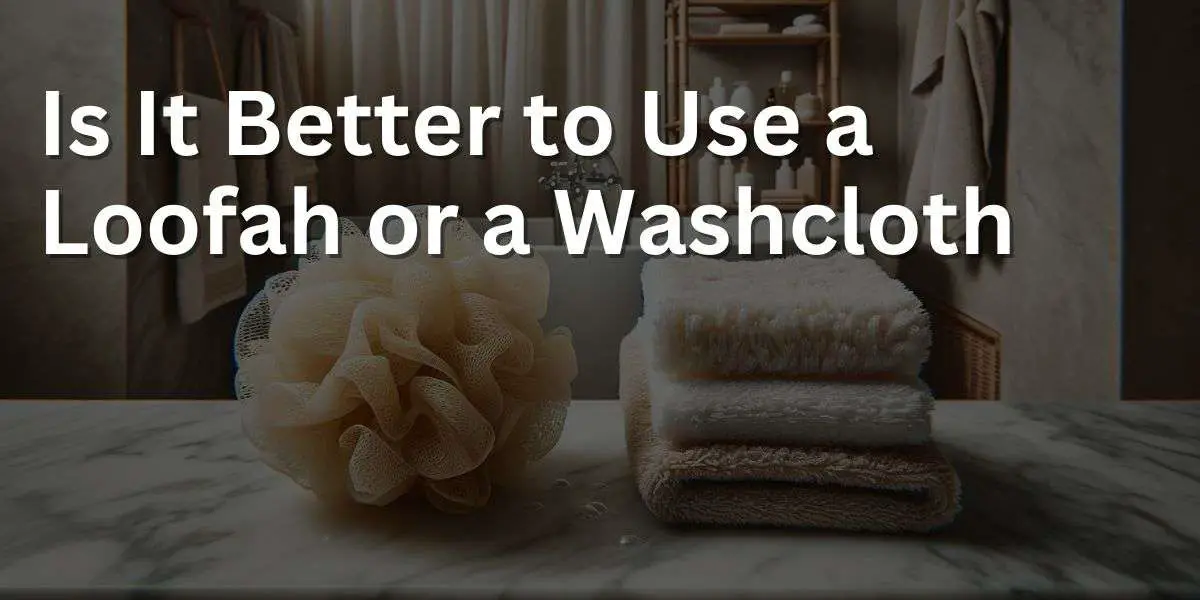Is it better to use a loofah or a washcloth? This question might seem simple, but the answer is key to refining your daily skincare routine.
In the following sections, we’ll exfoliate the surface of this debate and reveal the pros and cons of each bathing accessory. With a background in dermatology and a passion for skincare, I’m here to provide you with a detailed comparison based on hygiene, skin health, and effectiveness.
We’ll sift through textures, discuss how each option interacts with different skin types, and even touch on environmental impact. By the end of this post, you’ll be equipped with all the information needed to make an informed choice about which is the right tool for your bath-time ritual.
Are you ready to lather up the facts and make the best decision for your skin? Let’s dive in!
Key Takeaways: Is It Better to Use a Loofah or a Washcloth?
Loofahs offer more exfoliation compared to washcloths. The texture of a loofah is naturally designed to slough away dead skin cells, promoting smoother skin.
Washcloths are gentler on the skin. For those with sensitive skin, a soft washcloth may be less abrasive than a loofah, reducing the risk of irritation.
Loofahs can harbor bacteria if not dried properly. Due to their dense structure, loofahs may retain moisture and breed bacteria, so they need to be cleaned and dried thoroughly after each use.
Washcloths are easier to clean. Washcloths can be more hygienic as they can be easily washed in the laundry, ensuring you have a clean slate for each use.
Personal preference and skin type matter. The choice between a loofah and a washcloth ultimately depends on personal preference and individual skin needs; it’s beneficial to choose based on what feels best for your skin.
Rotate or replace frequently. Regardless of choice, it’s important to replace your loofah or washcloth regularly to maintain skin health and hygiene.
Effectiveness of Cleaning Washcloth vs Loofah
The effectiveness of loofahs compared to washcloths stands in their unique attributes conducive to an invigorating cleanse.
Loofahs, with their mesh-like texture, introduce an exfoliating factor to bathing routines, efficiently sloughing off dead skin cells and promoting skin rejuvenation. This contrasts with washcloths that offer a softer, more gentle cleansing experience suitable for daily use and sensitive skin.
Both tools, pivotal in personal hygiene, facilitate the active distribution of soap across the skin, but the choice hinges on individual skin needs and preferences. Regular cleansing and drying after use are essential to maintain their efficacy and hygiene, ensuring that each bath time is both cleansing and refreshing.
Washcloth Effectiveness of Cleaning
Washcloths stand out for their gentle yet effective cleaning capabilities. These cloths, typically made of soft fibers, are suitable for all skin types, providing a non-abrasive way to cleanse the skin. They work well to dislodge dirt and oil, making them efficient at maintaining personal cleanliness. Washcloths also promote hygiene by allowing for regular laundering, ensuring that each use is with a clean, germ-free cloth.
The versatility of washcloths extends to various uses, from facial cleansing to bathing, making them an indispensable part of daily washing rituals. Their softness is especially beneficial for sensitive skin, offering a soothing and comfortable experience. By incorporating washcloths into one’s daily routine, one can expect a consistent and nurturing way to achieve clean and cared-for skin.
Loofah Effectiveness of Cleaning
The effectiveness of loofahs in cleaning is a noteworthy aspect of personal hygiene routines. Loofahs, characterized by their porous texture, excel at exfoliating the skin. They work by removing dead skin cells, which encourages the renewal of the skin’s surface.
This process not only cleans but also revitalizes the skin, enhancing its ability to breathe and rejuvenate. When used with a cleansing agent, loofahs create a rich lather, offering a thorough and satisfying cleaning experience. Their structure allows for easy rinsing and drying, which is key in preventing bacterial growth, thereby supporting a clean and healthy bathing environment.
Embracing loofahs for their exfoliating properties can lead to a refreshed and vibrant skin tone, making them a valuable tool in any cleansing regimen.
Skin Type Consideration Loofah vs Washcloth
Choosing between a loofah and a washcloth largely depends on one’s skin type. For those with sensitive skin, a soft washcloth presents a gentle option, minimizing irritation while effectively cleansing the skin.
Conversely, a loofah offers a more exfoliating experience, suited for individuals with more resilient skin seeking to remove dead skin cells for a rejuvenated appearance. It’s key to consider personal skin sensitivity and cleansing needs when selecting between these two options, ensuring a positive and comfortable cleaning routine.
Regularly updating either item is crucial for maintaining skin health, as both can harbor bacteria over time. Properly caring for the chosen tool, whether a loofah or washcloth, will support skin health and contribute to an overall positive skincare practice.
Hygiene Factors Loofah vs Washcloth
Hygiene plays a pivotal role when comparing loofahs and washcloths. Loofahs, with their porous structure, can effectively exfoliate and cleanse but need frequent replacement to prevent bacterial growth.
Washcloths are less likely to trap bacteria, especially when washed regularly, making them a hygienic option for daily use. Users should prioritize drying these items in a well-ventilated space after each use to maintain optimal hygiene.
Embracing a routine that involves regular cleansing and drying of either a loofah or washcloth will ensure the hygiene factor remains high, contributing positively to one’s personal care routine.

Durability and Lifespan Loofah vs Washcloth
Durability and lifespan are key considerations when choosing between a loofah and a washcloth for personal hygiene.
Loofahs, derived from natural fibrous material, offer a robust exfoliating experience but tend to break down more quickly due to their organic composition.
In contrast, washcloths, typically made from woven fabrics, can withstand numerous washes and have a longer usable life. They maintain their texture and efficacy over time, representing a durable option.
Regular laundering and proper maintenance can extend the life of both items, but the inherent resilience of washcloths generally provides a longer-term solution for cleansing routines.
Environmental Impact Loofah vs Washcloth
The environmental impact of using loofahs compared to washcloths is a notable aspect of their sustainability profile.
Loofahs, grown as gourds and harvested for their natural fibrous skeletons, are biodegradable and contribute minimal waste to landfills. The cultivation of loofah plants also has the potential to absorb carbon dioxide, making them an eco-friendly choice.
Conversely, washcloths are often composed of cotton or synthetic blends. While cotton is a renewable resource, its farming can be resource-intensive. Synthetic fibers, on the other hand, may release microplastics during washing. However, the longevity of washcloths means fewer replacements and reduced consumption.
Both options, when sourced responsibly and utilized to their full lifespans, present eco-conscious choices for personal care with a positive environmental sentiment.
What is the Best Thing to Wash Yourself With?
We might think we can’t really go wrong washing ourselves. And yet there’s more to looking after your skin than simply jumping in a hot shower every morning. In fact you might not want to shower every day, especially in winter as it can actually have a drying effect on the skin and you might want to turn down the temperature, not just because it’s better for the planet but because it’s better for your skin. Using very hot water can strip the skin of more of its natural oils again leading to dryness.
What you wash yourself with is also important. Within that is the type of soap you choose and how you apply it to your skin. There are many types of soap available that are tailored to different skin types so spend time trying out different types until you find one that is right for you.
When it comes to choosing your bathing accessories there are a number of things to consider. The differences between a washcloth and loofah include how good they are at exfoliation, how easy they are to clean, what they are made of.
There is some debate about what is the best thing to wash yourself with, and many will say your hands are the best bet, but using something like a loofah or an exfoliating glove can improve circulation on the skin and help get rid of dead skin cells as well as helping the soap to foam.
Washcloth vs Loofah
There are a number of pros and cons to using both loofahs and washcloths.
A loofah is completely natural. It’s a dried gourd from the cucumber family. And the spongy texture makes it a great natural exfoliator. However, the structure of a loofah can make it a great place for bacteria to grow.
To avoid bacteria growing on your loofah make sure you rinse it thoroughly with hot water after use, wring it out as best you can and hang it up so it can thoroughly dry out between uses.
Washcloths tend to be gentler in terms of exfoliation than loofahs so they may be better for those with sensitive skin. They are also easier to clean as you can simply use them once and put them in the washing machine. Once again though they can harbor bacteria so you need to make sure you clean them regularly and probably don’t use the same one for your face as you do the rest of your body.
Are loofahs bad for your skin?
Loofahs have a reputation for exfoliating skin, removing dead cells, and providing a refreshing cleanse. However, it’s important to consider the type of loofah and the skin’s sensitivity. Natural loofahs, derived from the fibrous interior of the loofah plant, offer an organic option for those seeking a biodegradable tool to enhance their skincare routine. Synthetic versions, made from plastic or foam, provide a gentler exfoliation for those with more delicate skin.
The texture of loofahs contributes to their exfoliating properties, promoting healthy skin turnover and revealing the radiant skin beneath. When used with a gentle, circular motion, loofahs can effectively slough away rough patches without causing harm to the skin’s surface. The key lies in the method of use—light pressure allows the loofah to perform its job without abrasion.
Maintaining the cleanliness of the loofah is essential to its role as a skin-friendly tool. Regularly rinsing and drying the loofah prevents the accumulation of bacteria, ensuring that it remains safe and beneficial for every use. With proper care, including frequent replacement, loofahs can be a positive addition to a skincare regimen, especially for those looking to invigorate their skin through exfoliation.





